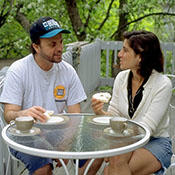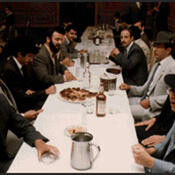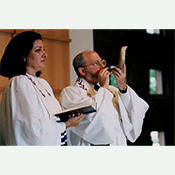Judaism
Facing Antisemitism
Jewish Continuity: The Next Generation
Feminism and Judaism
The Challenge of Assimilation
Spirituality: The Jewish Renewal Movement
Funeral and Mourning
The Synagogue
Under the Huppah: The Jewish Wedding
A Hasidic Tish
Bar and Bat Mitzvah
Purim
Brit Milah
Rosh Hashanah and Yom Kippur
Hanukkah
Pages
- first
- «
- 1
- 2
- 3
- 4
- 5
- 6
- 7
- 8
- 9
- 10
- 11
- 12
- 13
- 14
- 15
- 16
- 17
- 18
- 19
- 20
- 21
- 22
- 23
- 24
- 25
- 26
- 27
- 28
- 29
- 30
- 31
- 32
- 33
- 34
- 35
- 36
- 37
- 38
- 39
- 40
- 41
- 42
- 43
- 44
- 45
- 46
- 47
- 48
- 49
- 50
- 51
- 52
- 53
- 54
- 55
- 56
- 57
- 58
- 59
- 60
- 61
- 62
- 63
- 64
- 65
- 66
- 67
- 68
- 69
- 70
- 71
- 72
- 73
- 74
- 75
- 76
- 77
- 78
- 79
- 80
- 81
- 82
- 83
- 84
- 85
- 86
- 87
- 88
- 89
- 90
- 91
- 92
- 93
- 94
- 95
- 96
- 97
- 98
- 99
- 100
- 101
- 102
- 103
- 104
- 105
- 106
- 107
- 108
- 109
- 110
- 111
- 112
- 113
- 114
- 115
- 116
- 117
- 118
- 119
- 120
- 121
- 122
- 123
- 124
- 125
- 126
- 127
- 128
- 129
- 130
- 131
- 132
- 133
- 134
- 135
- 136
- 137
- 138
- 139
- 140
- 141
- 142
- 143
- 144
- 145
- 146
- 147
- 148
- 149
- 150
- 151
- 152
- 153
- 154
- 155
- 156
- 157
- 158
- 159
- 160
- 161
- 162
- 163
- 164
- 165
- 166
- 167
- 168
- 169
- 170
- 171
- 172
- 173
- 174
- 175
- 176
- 177
- 178
- 179
- 180
- 181
- 182
- 183
- 184
- 185
- 186
- 187
- 188
- 189
- 190
- 191
- 192
- 193
- 194
- 195
- 196
- 197
- 198
- 199
- 200
- 201
- 202
- 203
- 204
- 205
- 206
- 207
- 208
- 209
- 210
- 211
- 212
- 213
- 214
- 215
- 216
- 217
- 218
- 219
- 220
- 221
- 222
- 223
- 224
- 225
- 226
- 227
- 228
- 229
- 230
- 231
- 232
- 233
- 234
- 235
- 236
- 237
- 238
- 239
- 240
- 241
- 242
- 243
- 244
- 245
- 246
- 247
- 248
- 249
- 250
- 251
- 252
- 253
- 254
- 255
- 256
- 257
- 258
- 259
- 260
- 261
- 262
- 263
- 264
- 265
- 266
- 267
- 268
- 269
- 270
- 271
- 272
- 273
- 274
- 275
- 276
- 277
- 278
- 279
- 280
- 281
- 282
- 283
- 284
- 285
- 286
- 287
- 288
- 289
- 290
- 291
- 292
- 293
- 294
- 295
- 296
- 297
- 298
- 299
- 300
- 301
- 302
- 303
- 304
- 305
- 306
- 307
- 308
- 309
- 310
- 311
- 312
- 313
- 314
- 315
- 316
- 317
- »
- last









 The ultra-Orthodox Hasidic communities in America often live in close proximity, retaining a strong sense of identity distinct from secular American culture. A tish is an Orthodox Hasidic practice in which a ritual meal is shared between men in a Hasidic community and their rebbe, the Hasidims’ spiritual leader, after which the rebbe lectures on Jewish scriptures, the Torah and Talmud....
The ultra-Orthodox Hasidic communities in America often live in close proximity, retaining a strong sense of identity distinct from secular American culture. A tish is an Orthodox Hasidic practice in which a ritual meal is shared between men in a Hasidic community and their rebbe, the Hasidims’ spiritual leader, after which the rebbe lectures on Jewish scriptures, the Torah and Talmud....  The major rite of passage for Jewish boys and girls is the bar mitzvah (son of the commandment) and bat mitzvah (daughter of the commandment) service. The term refers both to the person and the ritual, in which Jewish children, at ages twelve or thirteen, and adult Jewish converts, lead their congregation for the first time in the recitation of a weekly Torah portion. They thereby begin full participation in Jewish congregational life, and the is often followed by a large celebration....
The major rite of passage for Jewish boys and girls is the bar mitzvah (son of the commandment) and bat mitzvah (daughter of the commandment) service. The term refers both to the person and the ritual, in which Jewish children, at ages twelve or thirteen, and adult Jewish converts, lead their congregation for the first time in the recitation of a weekly Torah portion. They thereby begin full participation in Jewish congregational life, and the is often followed by a large celebration.... 
 Brit milah is a rite of passage taking place eight days after the birth of Jewish males that symbolizes their entrance into a covenant with God through circumcision, or the removal of the foreskin of the penis. This is generally an occasion for a small family celebration. Some Jews hold similar rituals, involving only naming ceremonies, for newborn Jewish females....
Brit milah is a rite of passage taking place eight days after the birth of Jewish males that symbolizes their entrance into a covenant with God through circumcision, or the removal of the foreskin of the penis. This is generally an occasion for a small family celebration. Some Jews hold similar rituals, involving only naming ceremonies, for newborn Jewish females.... 
